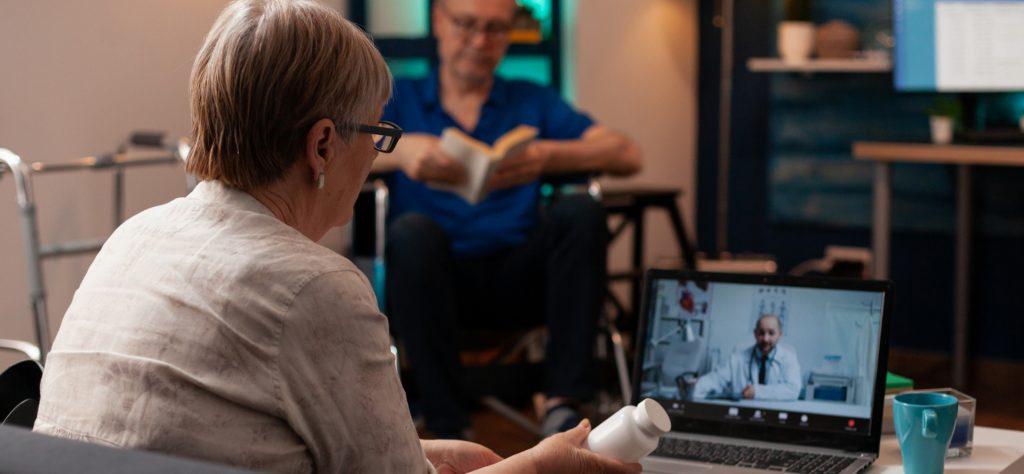Healthcare has changed dramatically in recent years. With the pace of innovation continuing to accelerate, what trends can we expect to see in health and social care in the near future?
Digital healthcare trends
In the coming years, we are likely to see technologies that are already being used in healthcare evolve and become better utilised across the sector. The healthcare trends that are being widely discussed at the moment include:
- Remote healthcare and telehealth
- Artificial intelligence (AI)
- Virtual and augmented reality
The evolution of remote healthcare and telehealth

Remote healthcare accelerated massively during the pandemic and it is here to stay. But in what capacity?
A McKinsey Consumer Health Insights Survey found that over half of patients prefer telehealth and virtual care to in-person appointments. It makes healthcare more convenient and accessible to patients, particularly those living in rural areas and those who don’t feel as comfortable leaving their homes.
In the future, we are likely to see remote healthcare become a tool that is used for conditions where virtual care and virtual appointments are appropriate. And rather than being a ‘must’, it will become part of a portfolio of options that both the patients and providers have to hand.
Physicians have regarded remote healthcare as suitable for the future treatment of ongoing chronic conditions. Virtual mental and behavioural healthcare also continues to have a high patient demand.
With data-driven wearable technology continuing to grow – and with plenty of room for further innovation and development in the future – this will also support the evolution of remote healthcare. Following on from a necessary period of integration to ensure that the right devices are used safely and effectively, wearable technology will enable real-time data collection, continuous monitoring and greater accuracy within telehealth.
Extensive use of artificial intelligence (AI) in healthcare
We’ve only scratched the surface on how AI can be used within healthcare. While there are challenges ahead with regards to its integration, it has the potential to greatly improve healthcare.
Here are just some of the ways in which using AI to make sense of healthcare data is set to be used in the future for greater efficiencies and patient outcomes:
Preventative medicine
AI has the potential to support the identification of health risks on both an individual and societal level, enabling preventive solutions to be put in place quickly.
Remote patient monitoring (RPM)
This is something that was useful during the coronavirus pandemic and is likely to be adopted further. RPM has the ability to support clinicians in effectively monitoring more of their patients remotely, leading to more efficient processes for all.
Quicker diagnosis for improved patient outcomes
Natural language processing (NLP) is a branch of AI which reads, interprets and organises data. In the future, it is set to be used to deliver insights to clinicians in order to support their diagnosis of conditions and delivery of treatment.
Proactive management of health
Wearable technology gives people access to more information about their health and wellbeing so that they can proactively manage their health. With wearable technology continuing to evolve, if and when this data becomes more accessible to clinicians, it will give them a better understanding of their patients so that they can provide more personalised care.
Virtual and augmented reality developments
Virtual reality (VR) is already starting to be used in mental health treatment, particularly for anxiety, eating disorders, phobias and post-traumatic stress disorder. The immersive experience gives people the opportunity to face challenges and practise techniques gained through therapy. VR is also being used to train medical professionals in surgical procedures and has also been used to perform surgery.
As VR in healthcare is still very much in the early stages, developments are being made so that virtual and augmented reality can be more widely used within healthcare in the future.
Following on from this evolution, it is likely that VR will play a significant role in medical education, delivering cost-effective, time-efficient, accessible and safer training. The developments will also result in VR becoming utilised further in global healthcare, being more widely used in countries where it is now available and also being introduced into countries without current access to VR.
Emerging healthcare trends to meet patient expectations
How patients want to experience healthcare has changed. These shifts in patient expectations are set to drive changes across healthcare in the years to come. These changes are likely to include:
- Greater information transparency
- Virtual and digital channels become the norm
- Access to more personalised care

The necessity of information transparency
Changes in consumer behaviour are influencing what patients now expect from healthcare.
Most people turn to the internet when looking for a doctor, dentist or clinic. Just as they expect from other industries, they want to be able to access a wealth of information in order to be able to make the right choices. When researching healthcare providers, people are often looking for insights into their quality of care, patient outcomes, price and patient satisfaction.
Platforms such as Doctify are adding this transparency into healthcare. As more healthcare providers look to meet this growing patient expectation and become more accessible online, this will result in patients feeling more empowered to make the right decisions for their health and wellbeing.
Virtual and digital communication channels become the norm
As mentioned earlier in the article, digital and virtual channels are set to evolve and become better utilised across healthcare in the coming years.
With COVID-19 seeing the introduction of more digital solutions in healthcare, they have been quickly adopted by large groups of patients. From booking appointments and speaking to consultants to requesting medication, it has made accessing healthcare speedier, easier and more convenient.
It is likely that for many patient groups, this will be something that they expect to see from providers going forward, becoming the norm for many people.
Wearable technology for more personalised care
Already, patients are more engaged and involved in their own health as a result of wearable technology .
In the coming years, the evolution of wearable technology is likely to result in more health-related data becoming available and increasingly smarter methods being used to analyse this information.
This will unlock even greater insights into a person’s health and wellbeing. In turn, it will help providers to get a better understanding of patients throughout their healthcare journey, leading to more efficient care and better patient outcomes.
At Doctify, we’re excited to be pushing forward the digital transformation of healthcare with our review intelligence platform. We work closely with providers so that they are able to gain meaningful insights, helping them to gain a better understanding of their patients’ experiences and what matters to them most.
If you would like to find out more about Doctify, please visit our Provider Centre to discover how our digital solutions can support you, your practice and your patients.




